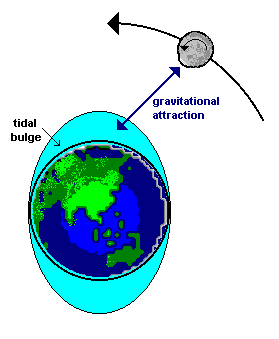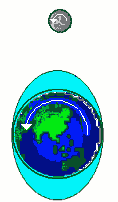| the Moon |
The other day I was talking to my brother-in-law about why the Moon ...
>You seem to spend a lot of time talking to your brother-in-law!
Pay attention.
The question was: Why does the Moon always present the same face to the Earth?
>That's easy. The Moon rotates about its axis in the same time it takes to rotate about the Earth!
And why is that?
>Huh?
When the Moon was formed, a jillion years ago, did it spin on its axis in about 28 days and revolve about the Earth in 28 days as well?

I stuck it there so you could see it was always presenting the same face to the Earth.
Anyway, here's the explanation I found ... for why we only see one side of the Moon, from Earth.
These "tidal forces" also slow down the Earth's rotation about its axis ... by about 0.0016 seconds per century. Eventually, the earth will slow its rotation so much that it'll keep one face toward the Moon. But, of course, the Earth is much larger than the Moon, so it's not so surprising that that's already happened to the Moon ... long ago. >That's a pretty big tidal bulge!
Anyway, we're saying that, in the distant past, the Moon's rotation about its axis was slowed so much that, today, it presents one face to the Earth. |  |
|
Of course, if the earth pulls on the Moon, the Moon also pulls on the Earth.
|  |
The vast majority of satellites whose rotation rates have been measured are "tidally locked", meaning their rotational period equals their orbital period.
>And you believe all this?
Why not?
The planet Pluto has a moon Charon.
Charon is a massive moon, compared to Pluto ... unlike the earth-moon system where our moon is quite small in comparison to the earth.
Charon also points one side toward Pluto at all times.
However, Pluto also keeps one side turned toward Charon.
The stable configuration between Pluto and Charon has already taken place.
>And we're next, eh?
I can hardly wait. 


